Comprehensive Report: Business Operations and Management Analysis
VerifiedAdded on 2023/06/05
|12
|3253
|161
Report
AI Summary
This report provides a detailed analysis of business operations, focusing on accounting, human resources, and team dynamics. It begins with an introduction to business operations and then delves into the significance of accounting for business success, exploring topics such as budget planning, decision-making, and record-keeping. The report then examines the functions of the HR department, including recruitment, training, and the impact of employment legislation. An accounting workshop section provides a sample income statement and its evaluation. The report also analyzes team roles, development stages, motivation theories, and leadership styles. The report concludes by emphasizing the importance of integrating these elements for overall business efficiency and success.
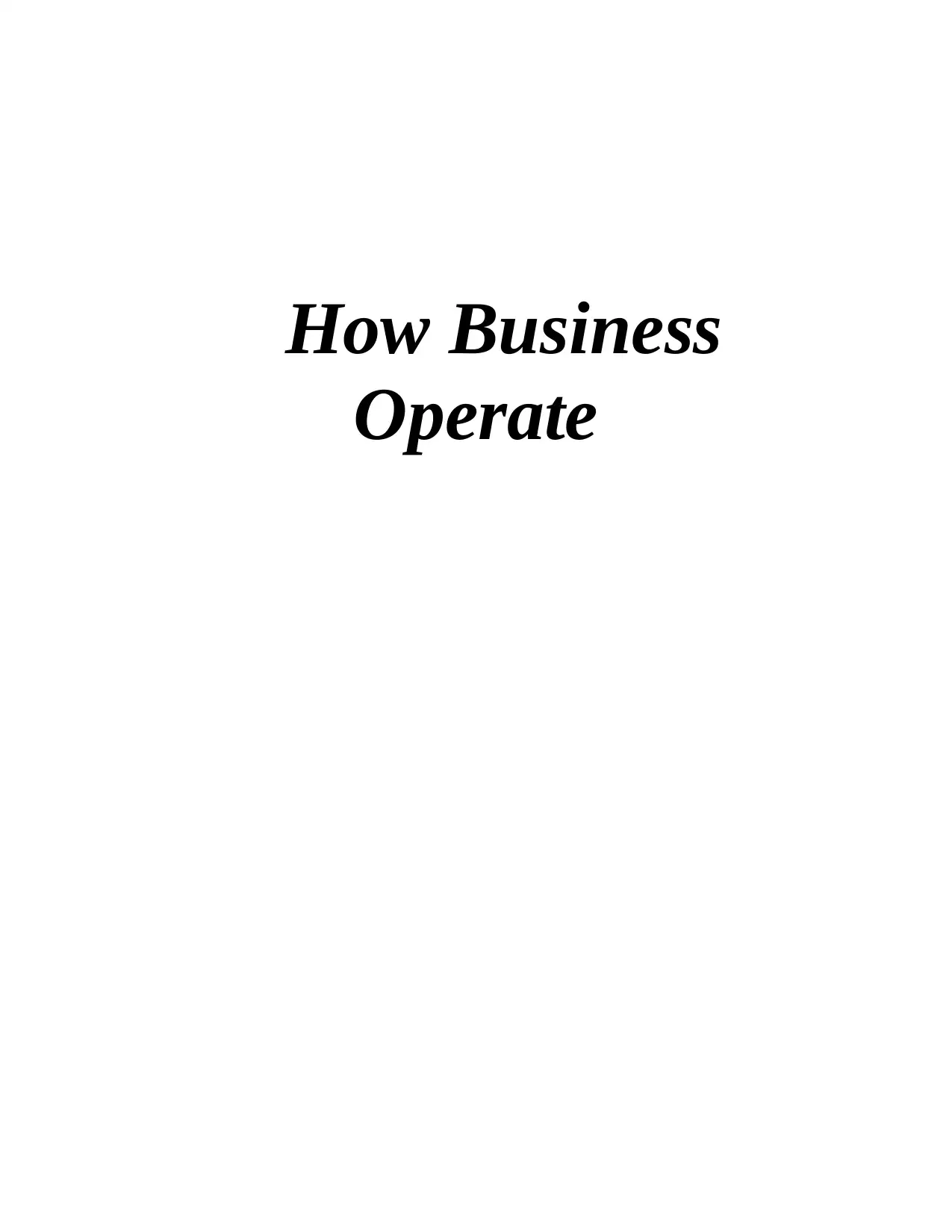
How Business
Operate
Operate
Paraphrase This Document
Need a fresh take? Get an instant paraphrase of this document with our AI Paraphraser
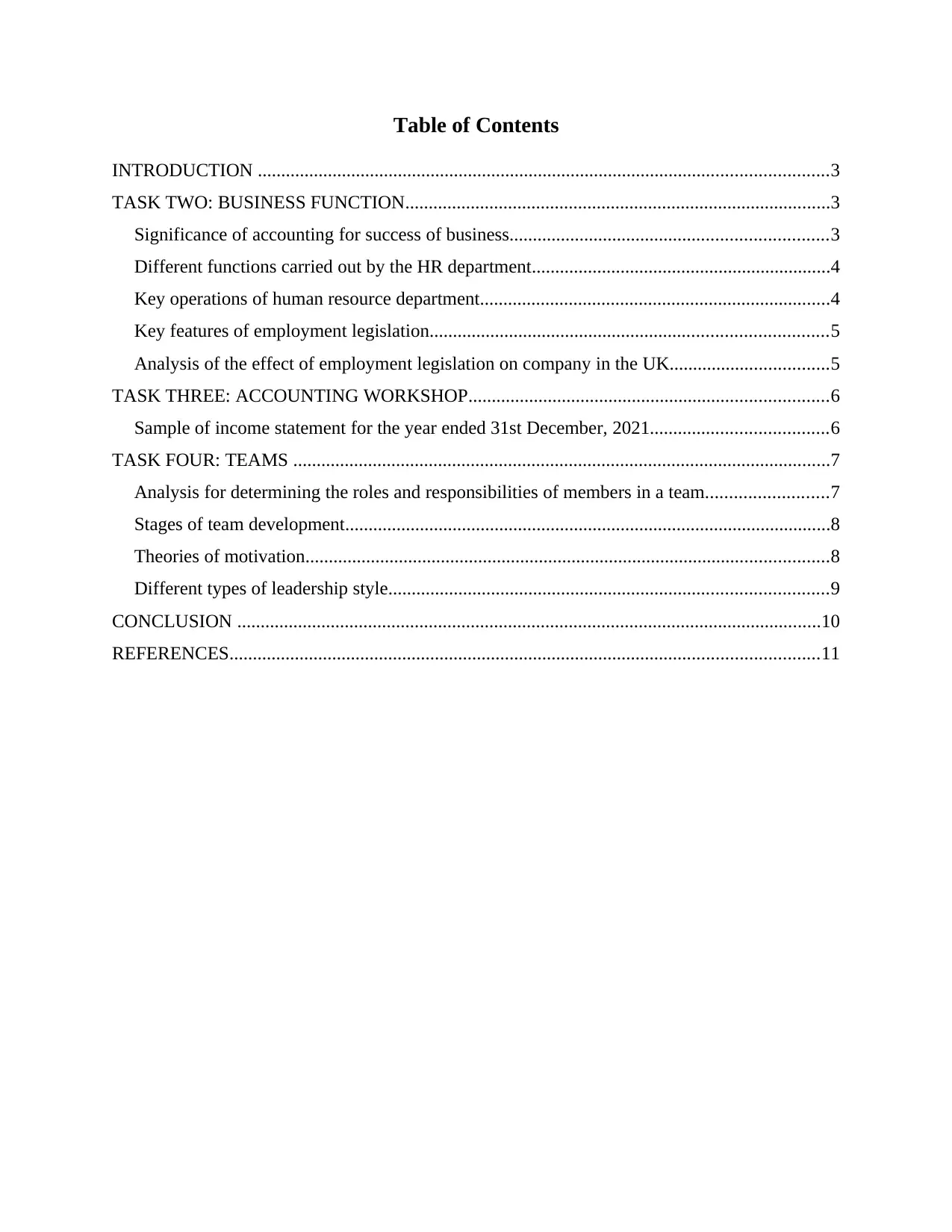
Table of Contents
INTRODUCTION ..........................................................................................................................3
TASK TWO: BUSINESS FUNCTION...........................................................................................3
Significance of accounting for success of business....................................................................3
Different functions carried out by the HR department................................................................4
Key operations of human resource department...........................................................................4
Key features of employment legislation.....................................................................................5
Analysis of the effect of employment legislation on company in the UK..................................5
TASK THREE: ACCOUNTING WORKSHOP.............................................................................6
Sample of income statement for the year ended 31st December, 2021......................................6
TASK FOUR: TEAMS ...................................................................................................................7
Analysis for determining the roles and responsibilities of members in a team..........................7
Stages of team development........................................................................................................8
Theories of motivation................................................................................................................8
Different types of leadership style..............................................................................................9
CONCLUSION .............................................................................................................................10
REFERENCES..............................................................................................................................11
INTRODUCTION ..........................................................................................................................3
TASK TWO: BUSINESS FUNCTION...........................................................................................3
Significance of accounting for success of business....................................................................3
Different functions carried out by the HR department................................................................4
Key operations of human resource department...........................................................................4
Key features of employment legislation.....................................................................................5
Analysis of the effect of employment legislation on company in the UK..................................5
TASK THREE: ACCOUNTING WORKSHOP.............................................................................6
Sample of income statement for the year ended 31st December, 2021......................................6
TASK FOUR: TEAMS ...................................................................................................................7
Analysis for determining the roles and responsibilities of members in a team..........................7
Stages of team development........................................................................................................8
Theories of motivation................................................................................................................8
Different types of leadership style..............................................................................................9
CONCLUSION .............................................................................................................................10
REFERENCES..............................................................................................................................11
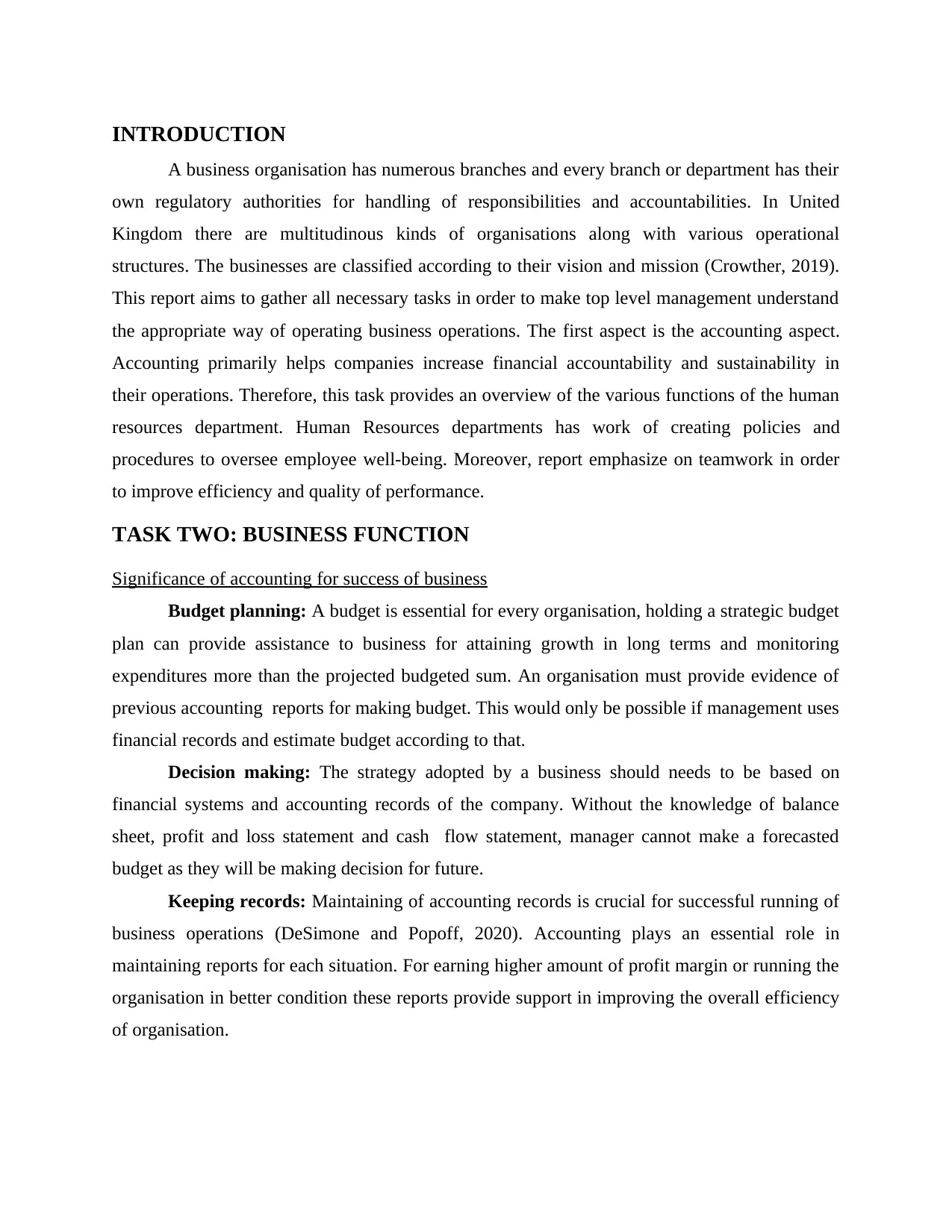
INTRODUCTION
A business organisation has numerous branches and every branch or department has their
own regulatory authorities for handling of responsibilities and accountabilities. In United
Kingdom there are multitudinous kinds of organisations along with various operational
structures. The businesses are classified according to their vision and mission (Crowther, 2019).
This report aims to gather all necessary tasks in order to make top level management understand
the appropriate way of operating business operations. The first aspect is the accounting aspect.
Accounting primarily helps companies increase financial accountability and sustainability in
their operations. Therefore, this task provides an overview of the various functions of the human
resources department. Human Resources departments has work of creating policies and
procedures to oversee employee well-being. Moreover, report emphasize on teamwork in order
to improve efficiency and quality of performance.
TASK TWO: BUSINESS FUNCTION
Significance of accounting for success of business
Budget planning: A budget is essential for every organisation, holding a strategic budget
plan can provide assistance to business for attaining growth in long terms and monitoring
expenditures more than the projected budgeted sum. An organisation must provide evidence of
previous accounting reports for making budget. This would only be possible if management uses
financial records and estimate budget according to that.
Decision making: The strategy adopted by a business should needs to be based on
financial systems and accounting records of the company. Without the knowledge of balance
sheet, profit and loss statement and cash flow statement, manager cannot make a forecasted
budget as they will be making decision for future.
Keeping records: Maintaining of accounting records is crucial for successful running of
business operations (DeSimone and Popoff, 2020). Accounting plays an essential role in
maintaining reports for each situation. For earning higher amount of profit margin or running the
organisation in better condition these reports provide support in improving the overall efficiency
of organisation.
A business organisation has numerous branches and every branch or department has their
own regulatory authorities for handling of responsibilities and accountabilities. In United
Kingdom there are multitudinous kinds of organisations along with various operational
structures. The businesses are classified according to their vision and mission (Crowther, 2019).
This report aims to gather all necessary tasks in order to make top level management understand
the appropriate way of operating business operations. The first aspect is the accounting aspect.
Accounting primarily helps companies increase financial accountability and sustainability in
their operations. Therefore, this task provides an overview of the various functions of the human
resources department. Human Resources departments has work of creating policies and
procedures to oversee employee well-being. Moreover, report emphasize on teamwork in order
to improve efficiency and quality of performance.
TASK TWO: BUSINESS FUNCTION
Significance of accounting for success of business
Budget planning: A budget is essential for every organisation, holding a strategic budget
plan can provide assistance to business for attaining growth in long terms and monitoring
expenditures more than the projected budgeted sum. An organisation must provide evidence of
previous accounting reports for making budget. This would only be possible if management uses
financial records and estimate budget according to that.
Decision making: The strategy adopted by a business should needs to be based on
financial systems and accounting records of the company. Without the knowledge of balance
sheet, profit and loss statement and cash flow statement, manager cannot make a forecasted
budget as they will be making decision for future.
Keeping records: Maintaining of accounting records is crucial for successful running of
business operations (DeSimone and Popoff, 2020). Accounting plays an essential role in
maintaining reports for each situation. For earning higher amount of profit margin or running the
organisation in better condition these reports provide support in improving the overall efficiency
of organisation.
⊘ This is a preview!⊘
Do you want full access?
Subscribe today to unlock all pages.

Trusted by 1+ million students worldwide
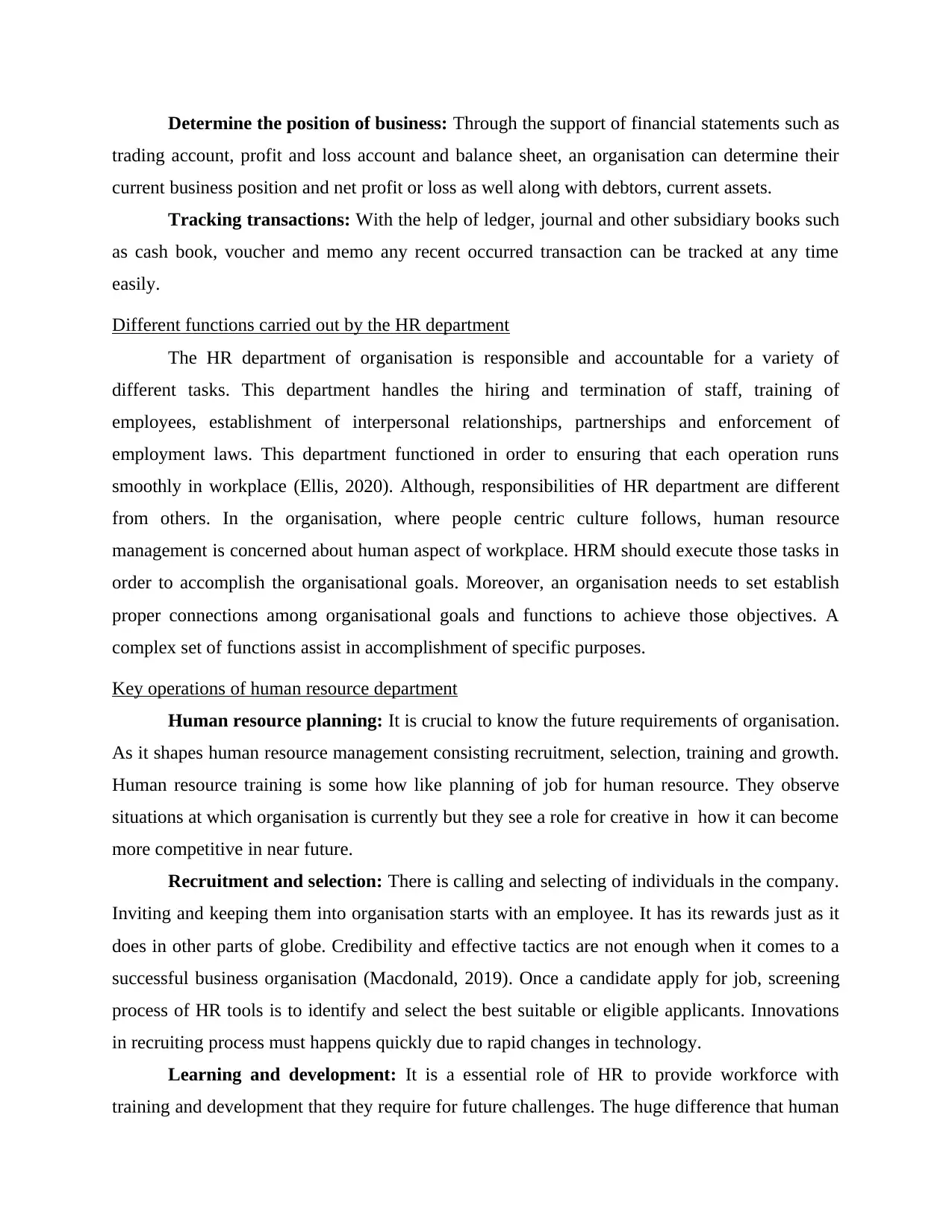
Determine the position of business: Through the support of financial statements such as
trading account, profit and loss account and balance sheet, an organisation can determine their
current business position and net profit or loss as well along with debtors, current assets.
Tracking transactions: With the help of ledger, journal and other subsidiary books such
as cash book, voucher and memo any recent occurred transaction can be tracked at any time
easily.
Different functions carried out by the HR department
The HR department of organisation is responsible and accountable for a variety of
different tasks. This department handles the hiring and termination of staff, training of
employees, establishment of interpersonal relationships, partnerships and enforcement of
employment laws. This department functioned in order to ensuring that each operation runs
smoothly in workplace (Ellis, 2020). Although, responsibilities of HR department are different
from others. In the organisation, where people centric culture follows, human resource
management is concerned about human aspect of workplace. HRM should execute those tasks in
order to accomplish the organisational goals. Moreover, an organisation needs to set establish
proper connections among organisational goals and functions to achieve those objectives. A
complex set of functions assist in accomplishment of specific purposes.
Key operations of human resource department
Human resource planning: It is crucial to know the future requirements of organisation.
As it shapes human resource management consisting recruitment, selection, training and growth.
Human resource training is some how like planning of job for human resource. They observe
situations at which organisation is currently but they see a role for creative in how it can become
more competitive in near future.
Recruitment and selection: There is calling and selecting of individuals in the company.
Inviting and keeping them into organisation starts with an employee. It has its rewards just as it
does in other parts of globe. Credibility and effective tactics are not enough when it comes to a
successful business organisation (Macdonald, 2019). Once a candidate apply for job, screening
process of HR tools is to identify and select the best suitable or eligible applicants. Innovations
in recruiting process must happens quickly due to rapid changes in technology.
Learning and development: It is a essential role of HR to provide workforce with
training and development that they require for future challenges. The huge difference that human
trading account, profit and loss account and balance sheet, an organisation can determine their
current business position and net profit or loss as well along with debtors, current assets.
Tracking transactions: With the help of ledger, journal and other subsidiary books such
as cash book, voucher and memo any recent occurred transaction can be tracked at any time
easily.
Different functions carried out by the HR department
The HR department of organisation is responsible and accountable for a variety of
different tasks. This department handles the hiring and termination of staff, training of
employees, establishment of interpersonal relationships, partnerships and enforcement of
employment laws. This department functioned in order to ensuring that each operation runs
smoothly in workplace (Ellis, 2020). Although, responsibilities of HR department are different
from others. In the organisation, where people centric culture follows, human resource
management is concerned about human aspect of workplace. HRM should execute those tasks in
order to accomplish the organisational goals. Moreover, an organisation needs to set establish
proper connections among organisational goals and functions to achieve those objectives. A
complex set of functions assist in accomplishment of specific purposes.
Key operations of human resource department
Human resource planning: It is crucial to know the future requirements of organisation.
As it shapes human resource management consisting recruitment, selection, training and growth.
Human resource training is some how like planning of job for human resource. They observe
situations at which organisation is currently but they see a role for creative in how it can become
more competitive in near future.
Recruitment and selection: There is calling and selecting of individuals in the company.
Inviting and keeping them into organisation starts with an employee. It has its rewards just as it
does in other parts of globe. Credibility and effective tactics are not enough when it comes to a
successful business organisation (Macdonald, 2019). Once a candidate apply for job, screening
process of HR tools is to identify and select the best suitable or eligible applicants. Innovations
in recruiting process must happens quickly due to rapid changes in technology.
Learning and development: It is a essential role of HR to provide workforce with
training and development that they require for future challenges. The huge difference that human
Paraphrase This Document
Need a fresh take? Get an instant paraphrase of this document with our AI Paraphraser
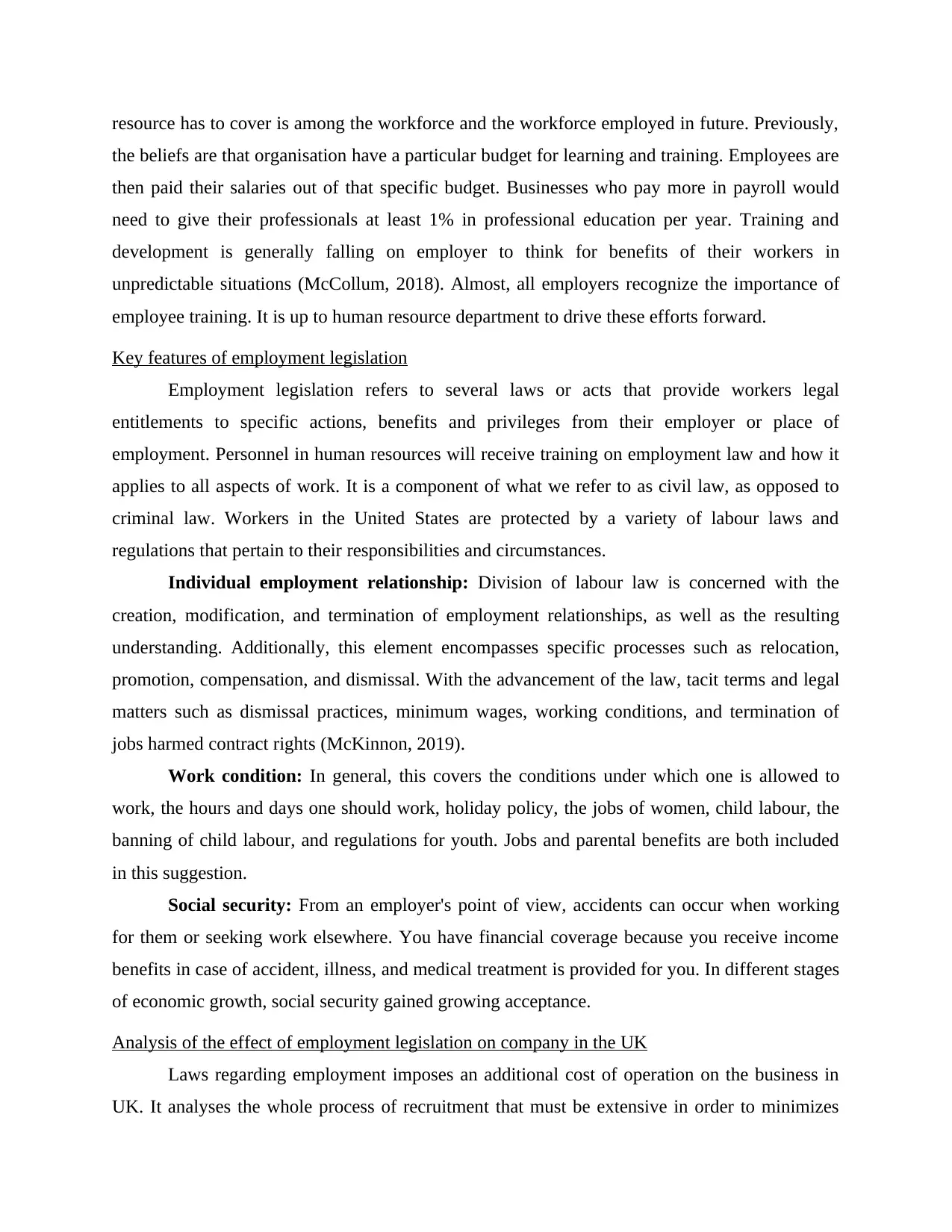
resource has to cover is among the workforce and the workforce employed in future. Previously,
the beliefs are that organisation have a particular budget for learning and training. Employees are
then paid their salaries out of that specific budget. Businesses who pay more in payroll would
need to give their professionals at least 1% in professional education per year. Training and
development is generally falling on employer to think for benefits of their workers in
unpredictable situations (McCollum, 2018). Almost, all employers recognize the importance of
employee training. It is up to human resource department to drive these efforts forward.
Key features of employment legislation
Employment legislation refers to several laws or acts that provide workers legal
entitlements to specific actions, benefits and privileges from their employer or place of
employment. Personnel in human resources will receive training on employment law and how it
applies to all aspects of work. It is a component of what we refer to as civil law, as opposed to
criminal law. Workers in the United States are protected by a variety of labour laws and
regulations that pertain to their responsibilities and circumstances.
Individual employment relationship: Division of labour law is concerned with the
creation, modification, and termination of employment relationships, as well as the resulting
understanding. Additionally, this element encompasses specific processes such as relocation,
promotion, compensation, and dismissal. With the advancement of the law, tacit terms and legal
matters such as dismissal practices, minimum wages, working conditions, and termination of
jobs harmed contract rights (McKinnon, 2019).
Work condition: In general, this covers the conditions under which one is allowed to
work, the hours and days one should work, holiday policy, the jobs of women, child labour, the
banning of child labour, and regulations for youth. Jobs and parental benefits are both included
in this suggestion.
Social security: From an employer's point of view, accidents can occur when working
for them or seeking work elsewhere. You have financial coverage because you receive income
benefits in case of accident, illness, and medical treatment is provided for you. In different stages
of economic growth, social security gained growing acceptance.
Analysis of the effect of employment legislation on company in the UK
Laws regarding employment imposes an additional cost of operation on the business in
UK. It analyses the whole process of recruitment that must be extensive in order to minimizes
the beliefs are that organisation have a particular budget for learning and training. Employees are
then paid their salaries out of that specific budget. Businesses who pay more in payroll would
need to give their professionals at least 1% in professional education per year. Training and
development is generally falling on employer to think for benefits of their workers in
unpredictable situations (McCollum, 2018). Almost, all employers recognize the importance of
employee training. It is up to human resource department to drive these efforts forward.
Key features of employment legislation
Employment legislation refers to several laws or acts that provide workers legal
entitlements to specific actions, benefits and privileges from their employer or place of
employment. Personnel in human resources will receive training on employment law and how it
applies to all aspects of work. It is a component of what we refer to as civil law, as opposed to
criminal law. Workers in the United States are protected by a variety of labour laws and
regulations that pertain to their responsibilities and circumstances.
Individual employment relationship: Division of labour law is concerned with the
creation, modification, and termination of employment relationships, as well as the resulting
understanding. Additionally, this element encompasses specific processes such as relocation,
promotion, compensation, and dismissal. With the advancement of the law, tacit terms and legal
matters such as dismissal practices, minimum wages, working conditions, and termination of
jobs harmed contract rights (McKinnon, 2019).
Work condition: In general, this covers the conditions under which one is allowed to
work, the hours and days one should work, holiday policy, the jobs of women, child labour, the
banning of child labour, and regulations for youth. Jobs and parental benefits are both included
in this suggestion.
Social security: From an employer's point of view, accidents can occur when working
for them or seeking work elsewhere. You have financial coverage because you receive income
benefits in case of accident, illness, and medical treatment is provided for you. In different stages
of economic growth, social security gained growing acceptance.
Analysis of the effect of employment legislation on company in the UK
Laws regarding employment imposes an additional cost of operation on the business in
UK. It analyses the whole process of recruitment that must be extensive in order to minimizes
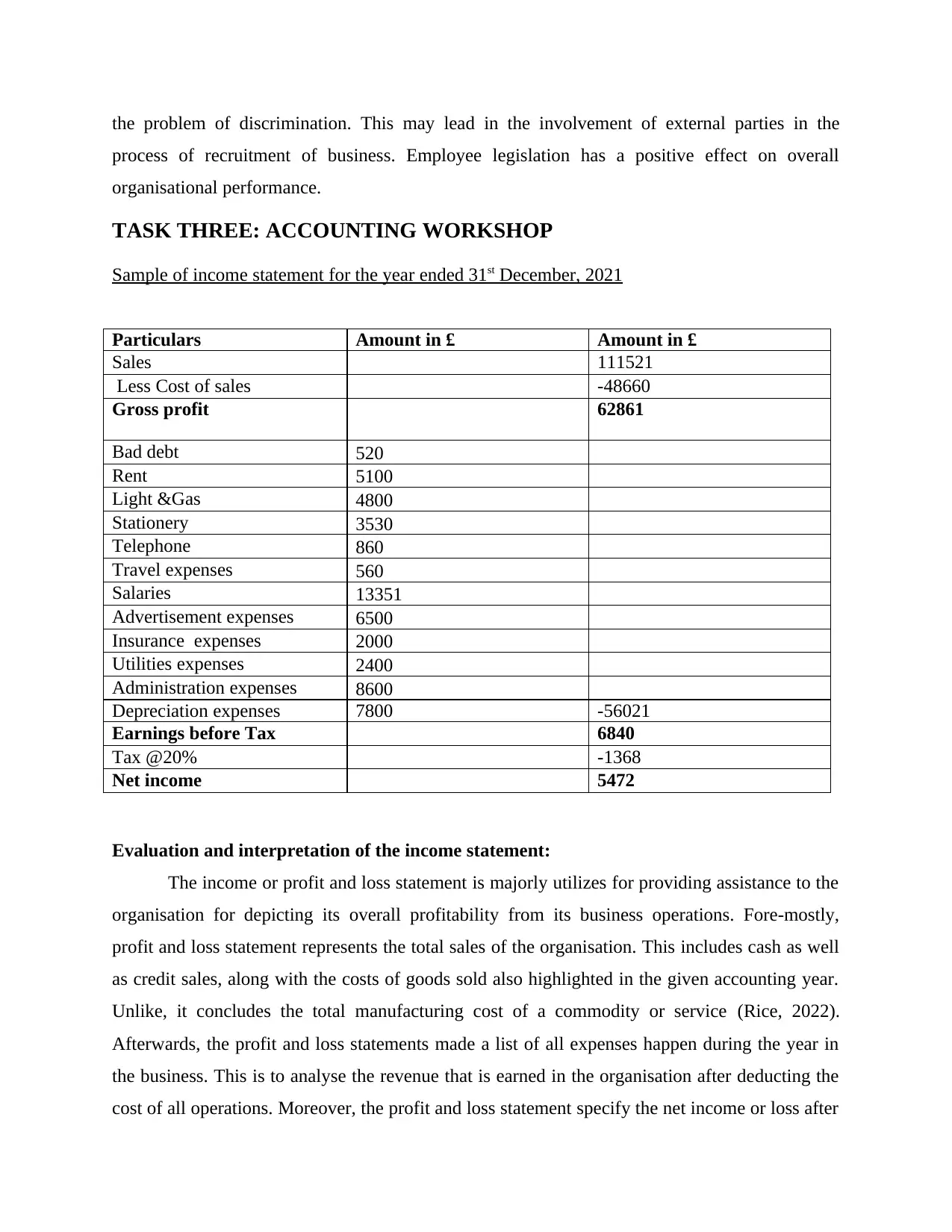
the problem of discrimination. This may lead in the involvement of external parties in the
process of recruitment of business. Employee legislation has a positive effect on overall
organisational performance.
TASK THREE: ACCOUNTING WORKSHOP
Sample of income statement for the year ended 31st December, 2021
Particulars Amount in £ Amount in £
Sales 111521
Less Cost of sales -48660
Gross profit 62861
Bad debt 520
Rent 5100
Light &Gas 4800
Stationery 3530
Telephone 860
Travel expenses 560
Salaries 13351
Advertisement expenses 6500
Insurance expenses 2000
Utilities expenses 2400
Administration expenses 8600
Depreciation expenses 7800 -56021
Earnings before Tax 6840
Tax @20% -1368
Net income 5472
Evaluation and interpretation of the income statement:
The income or profit and loss statement is majorly utilizes for providing assistance to the
organisation for depicting its overall profitability from its business operations. Fore-mostly,
profit and loss statement represents the total sales of the organisation. This includes cash as well
as credit sales, along with the costs of goods sold also highlighted in the given accounting year.
Unlike, it concludes the total manufacturing cost of a commodity or service (Rice, 2022).
Afterwards, the profit and loss statements made a list of all expenses happen during the year in
the business. This is to analyse the revenue that is earned in the organisation after deducting the
cost of all operations. Moreover, the profit and loss statement specify the net income or loss after
process of recruitment of business. Employee legislation has a positive effect on overall
organisational performance.
TASK THREE: ACCOUNTING WORKSHOP
Sample of income statement for the year ended 31st December, 2021
Particulars Amount in £ Amount in £
Sales 111521
Less Cost of sales -48660
Gross profit 62861
Bad debt 520
Rent 5100
Light &Gas 4800
Stationery 3530
Telephone 860
Travel expenses 560
Salaries 13351
Advertisement expenses 6500
Insurance expenses 2000
Utilities expenses 2400
Administration expenses 8600
Depreciation expenses 7800 -56021
Earnings before Tax 6840
Tax @20% -1368
Net income 5472
Evaluation and interpretation of the income statement:
The income or profit and loss statement is majorly utilizes for providing assistance to the
organisation for depicting its overall profitability from its business operations. Fore-mostly,
profit and loss statement represents the total sales of the organisation. This includes cash as well
as credit sales, along with the costs of goods sold also highlighted in the given accounting year.
Unlike, it concludes the total manufacturing cost of a commodity or service (Rice, 2022).
Afterwards, the profit and loss statements made a list of all expenses happen during the year in
the business. This is to analyse the revenue that is earned in the organisation after deducting the
cost of all operations. Moreover, the profit and loss statement specify the net income or loss after
⊘ This is a preview!⊘
Do you want full access?
Subscribe today to unlock all pages.

Trusted by 1+ million students worldwide
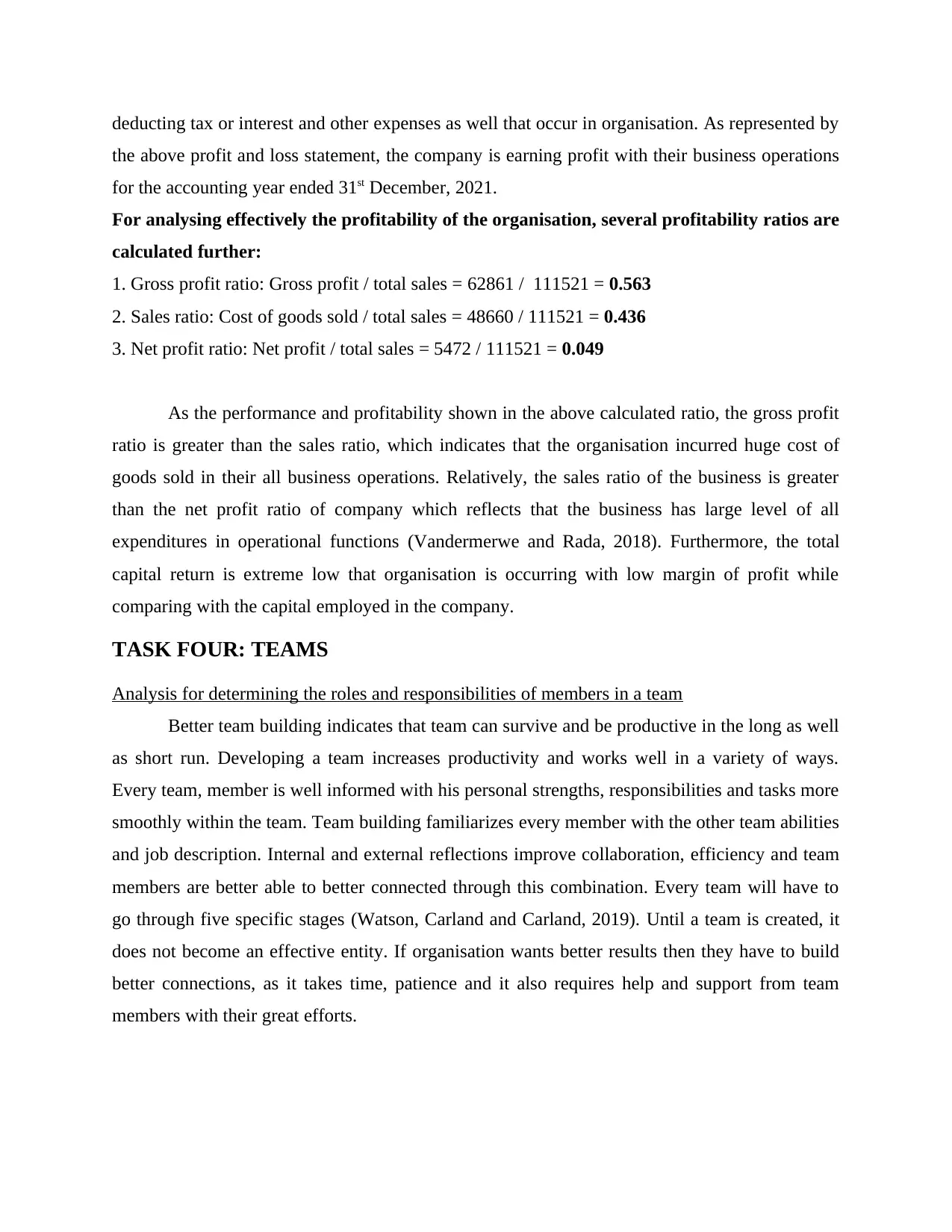
deducting tax or interest and other expenses as well that occur in organisation. As represented by
the above profit and loss statement, the company is earning profit with their business operations
for the accounting year ended 31st December, 2021.
For analysing effectively the profitability of the organisation, several profitability ratios are
calculated further:
1. Gross profit ratio: Gross profit / total sales = 62861 / 111521 = 0.563
2. Sales ratio: Cost of goods sold / total sales = 48660 / 111521 = 0.436
3. Net profit ratio: Net profit / total sales = 5472 / 111521 = 0.049
As the performance and profitability shown in the above calculated ratio, the gross profit
ratio is greater than the sales ratio, which indicates that the organisation incurred huge cost of
goods sold in their all business operations. Relatively, the sales ratio of the business is greater
than the net profit ratio of company which reflects that the business has large level of all
expenditures in operational functions (Vandermerwe and Rada, 2018). Furthermore, the total
capital return is extreme low that organisation is occurring with low margin of profit while
comparing with the capital employed in the company.
TASK FOUR: TEAMS
Analysis for determining the roles and responsibilities of members in a team
Better team building indicates that team can survive and be productive in the long as well
as short run. Developing a team increases productivity and works well in a variety of ways.
Every team, member is well informed with his personal strengths, responsibilities and tasks more
smoothly within the team. Team building familiarizes every member with the other team abilities
and job description. Internal and external reflections improve collaboration, efficiency and team
members are better able to better connected through this combination. Every team will have to
go through five specific stages (Watson, Carland and Carland, 2019). Until a team is created, it
does not become an effective entity. If organisation wants better results then they have to build
better connections, as it takes time, patience and it also requires help and support from team
members with their great efforts.
the above profit and loss statement, the company is earning profit with their business operations
for the accounting year ended 31st December, 2021.
For analysing effectively the profitability of the organisation, several profitability ratios are
calculated further:
1. Gross profit ratio: Gross profit / total sales = 62861 / 111521 = 0.563
2. Sales ratio: Cost of goods sold / total sales = 48660 / 111521 = 0.436
3. Net profit ratio: Net profit / total sales = 5472 / 111521 = 0.049
As the performance and profitability shown in the above calculated ratio, the gross profit
ratio is greater than the sales ratio, which indicates that the organisation incurred huge cost of
goods sold in their all business operations. Relatively, the sales ratio of the business is greater
than the net profit ratio of company which reflects that the business has large level of all
expenditures in operational functions (Vandermerwe and Rada, 2018). Furthermore, the total
capital return is extreme low that organisation is occurring with low margin of profit while
comparing with the capital employed in the company.
TASK FOUR: TEAMS
Analysis for determining the roles and responsibilities of members in a team
Better team building indicates that team can survive and be productive in the long as well
as short run. Developing a team increases productivity and works well in a variety of ways.
Every team, member is well informed with his personal strengths, responsibilities and tasks more
smoothly within the team. Team building familiarizes every member with the other team abilities
and job description. Internal and external reflections improve collaboration, efficiency and team
members are better able to better connected through this combination. Every team will have to
go through five specific stages (Watson, Carland and Carland, 2019). Until a team is created, it
does not become an effective entity. If organisation wants better results then they have to build
better connections, as it takes time, patience and it also requires help and support from team
members with their great efforts.
Paraphrase This Document
Need a fresh take? Get an instant paraphrase of this document with our AI Paraphraser
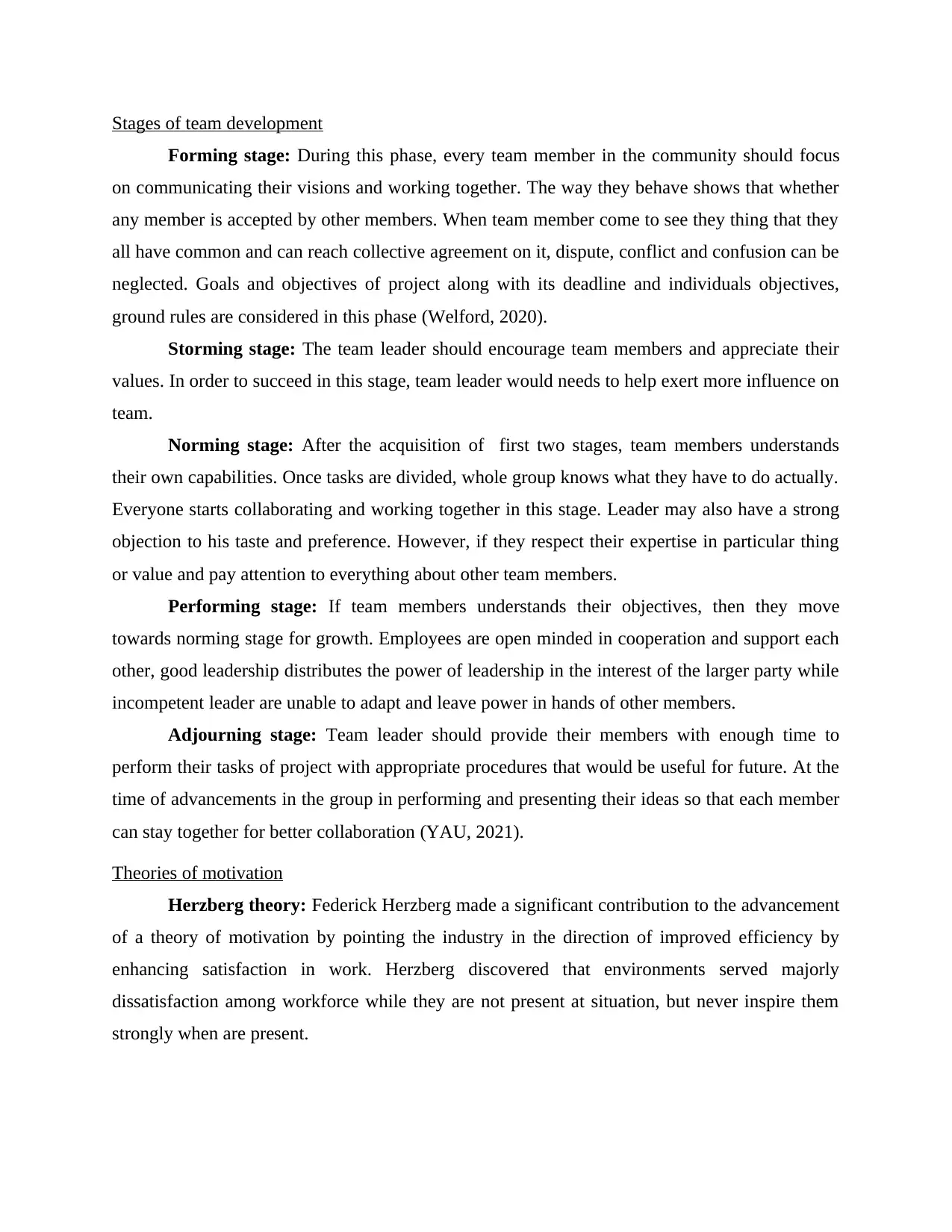
Stages of team development
Forming stage: During this phase, every team member in the community should focus
on communicating their visions and working together. The way they behave shows that whether
any member is accepted by other members. When team member come to see they thing that they
all have common and can reach collective agreement on it, dispute, conflict and confusion can be
neglected. Goals and objectives of project along with its deadline and individuals objectives,
ground rules are considered in this phase (Welford, 2020).
Storming stage: The team leader should encourage team members and appreciate their
values. In order to succeed in this stage, team leader would needs to help exert more influence on
team.
Norming stage: After the acquisition of first two stages, team members understands
their own capabilities. Once tasks are divided, whole group knows what they have to do actually.
Everyone starts collaborating and working together in this stage. Leader may also have a strong
objection to his taste and preference. However, if they respect their expertise in particular thing
or value and pay attention to everything about other team members.
Performing stage: If team members understands their objectives, then they move
towards norming stage for growth. Employees are open minded in cooperation and support each
other, good leadership distributes the power of leadership in the interest of the larger party while
incompetent leader are unable to adapt and leave power in hands of other members.
Adjourning stage: Team leader should provide their members with enough time to
perform their tasks of project with appropriate procedures that would be useful for future. At the
time of advancements in the group in performing and presenting their ideas so that each member
can stay together for better collaboration (YAU, 2021).
Theories of motivation
Herzberg theory: Federick Herzberg made a significant contribution to the advancement
of a theory of motivation by pointing the industry in the direction of improved efficiency by
enhancing satisfaction in work. Herzberg discovered that environments served majorly
dissatisfaction among workforce while they are not present at situation, but never inspire them
strongly when are present.
Forming stage: During this phase, every team member in the community should focus
on communicating their visions and working together. The way they behave shows that whether
any member is accepted by other members. When team member come to see they thing that they
all have common and can reach collective agreement on it, dispute, conflict and confusion can be
neglected. Goals and objectives of project along with its deadline and individuals objectives,
ground rules are considered in this phase (Welford, 2020).
Storming stage: The team leader should encourage team members and appreciate their
values. In order to succeed in this stage, team leader would needs to help exert more influence on
team.
Norming stage: After the acquisition of first two stages, team members understands
their own capabilities. Once tasks are divided, whole group knows what they have to do actually.
Everyone starts collaborating and working together in this stage. Leader may also have a strong
objection to his taste and preference. However, if they respect their expertise in particular thing
or value and pay attention to everything about other team members.
Performing stage: If team members understands their objectives, then they move
towards norming stage for growth. Employees are open minded in cooperation and support each
other, good leadership distributes the power of leadership in the interest of the larger party while
incompetent leader are unable to adapt and leave power in hands of other members.
Adjourning stage: Team leader should provide their members with enough time to
perform their tasks of project with appropriate procedures that would be useful for future. At the
time of advancements in the group in performing and presenting their ideas so that each member
can stay together for better collaboration (YAU, 2021).
Theories of motivation
Herzberg theory: Federick Herzberg made a significant contribution to the advancement
of a theory of motivation by pointing the industry in the direction of improved efficiency by
enhancing satisfaction in work. Herzberg discovered that environments served majorly
dissatisfaction among workforce while they are not present at situation, but never inspire them
strongly when are present.
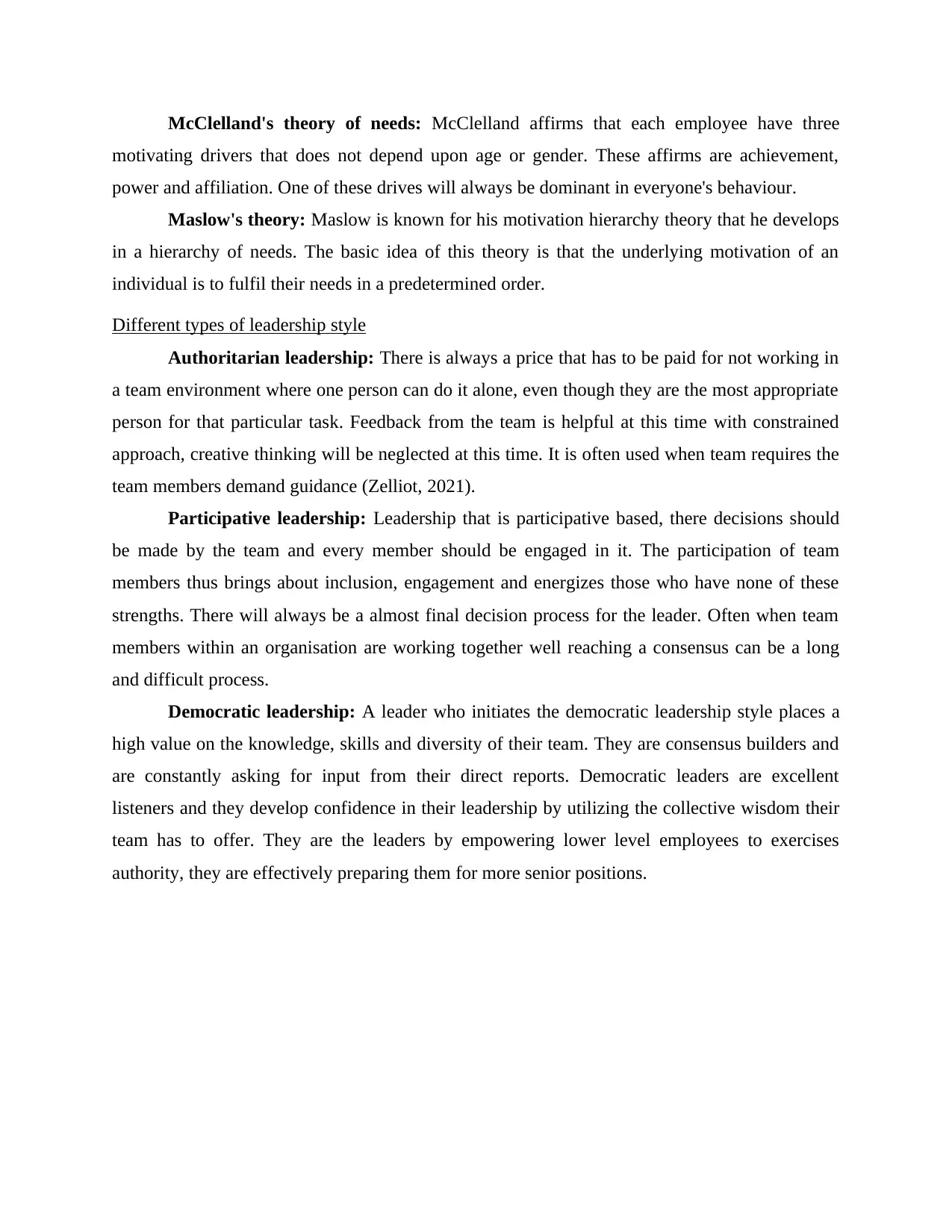
McClelland's theory of needs: McClelland affirms that each employee have three
motivating drivers that does not depend upon age or gender. These affirms are achievement,
power and affiliation. One of these drives will always be dominant in everyone's behaviour.
Maslow's theory: Maslow is known for his motivation hierarchy theory that he develops
in a hierarchy of needs. The basic idea of this theory is that the underlying motivation of an
individual is to fulfil their needs in a predetermined order.
Different types of leadership style
Authoritarian leadership: There is always a price that has to be paid for not working in
a team environment where one person can do it alone, even though they are the most appropriate
person for that particular task. Feedback from the team is helpful at this time with constrained
approach, creative thinking will be neglected at this time. It is often used when team requires the
team members demand guidance (Zelliot, 2021).
Participative leadership: Leadership that is participative based, there decisions should
be made by the team and every member should be engaged in it. The participation of team
members thus brings about inclusion, engagement and energizes those who have none of these
strengths. There will always be a almost final decision process for the leader. Often when team
members within an organisation are working together well reaching a consensus can be a long
and difficult process.
Democratic leadership: A leader who initiates the democratic leadership style places a
high value on the knowledge, skills and diversity of their team. They are consensus builders and
are constantly asking for input from their direct reports. Democratic leaders are excellent
listeners and they develop confidence in their leadership by utilizing the collective wisdom their
team has to offer. They are the leaders by empowering lower level employees to exercises
authority, they are effectively preparing them for more senior positions.
motivating drivers that does not depend upon age or gender. These affirms are achievement,
power and affiliation. One of these drives will always be dominant in everyone's behaviour.
Maslow's theory: Maslow is known for his motivation hierarchy theory that he develops
in a hierarchy of needs. The basic idea of this theory is that the underlying motivation of an
individual is to fulfil their needs in a predetermined order.
Different types of leadership style
Authoritarian leadership: There is always a price that has to be paid for not working in
a team environment where one person can do it alone, even though they are the most appropriate
person for that particular task. Feedback from the team is helpful at this time with constrained
approach, creative thinking will be neglected at this time. It is often used when team requires the
team members demand guidance (Zelliot, 2021).
Participative leadership: Leadership that is participative based, there decisions should
be made by the team and every member should be engaged in it. The participation of team
members thus brings about inclusion, engagement and energizes those who have none of these
strengths. There will always be a almost final decision process for the leader. Often when team
members within an organisation are working together well reaching a consensus can be a long
and difficult process.
Democratic leadership: A leader who initiates the democratic leadership style places a
high value on the knowledge, skills and diversity of their team. They are consensus builders and
are constantly asking for input from their direct reports. Democratic leaders are excellent
listeners and they develop confidence in their leadership by utilizing the collective wisdom their
team has to offer. They are the leaders by empowering lower level employees to exercises
authority, they are effectively preparing them for more senior positions.
⊘ This is a preview!⊘
Do you want full access?
Subscribe today to unlock all pages.

Trusted by 1+ million students worldwide
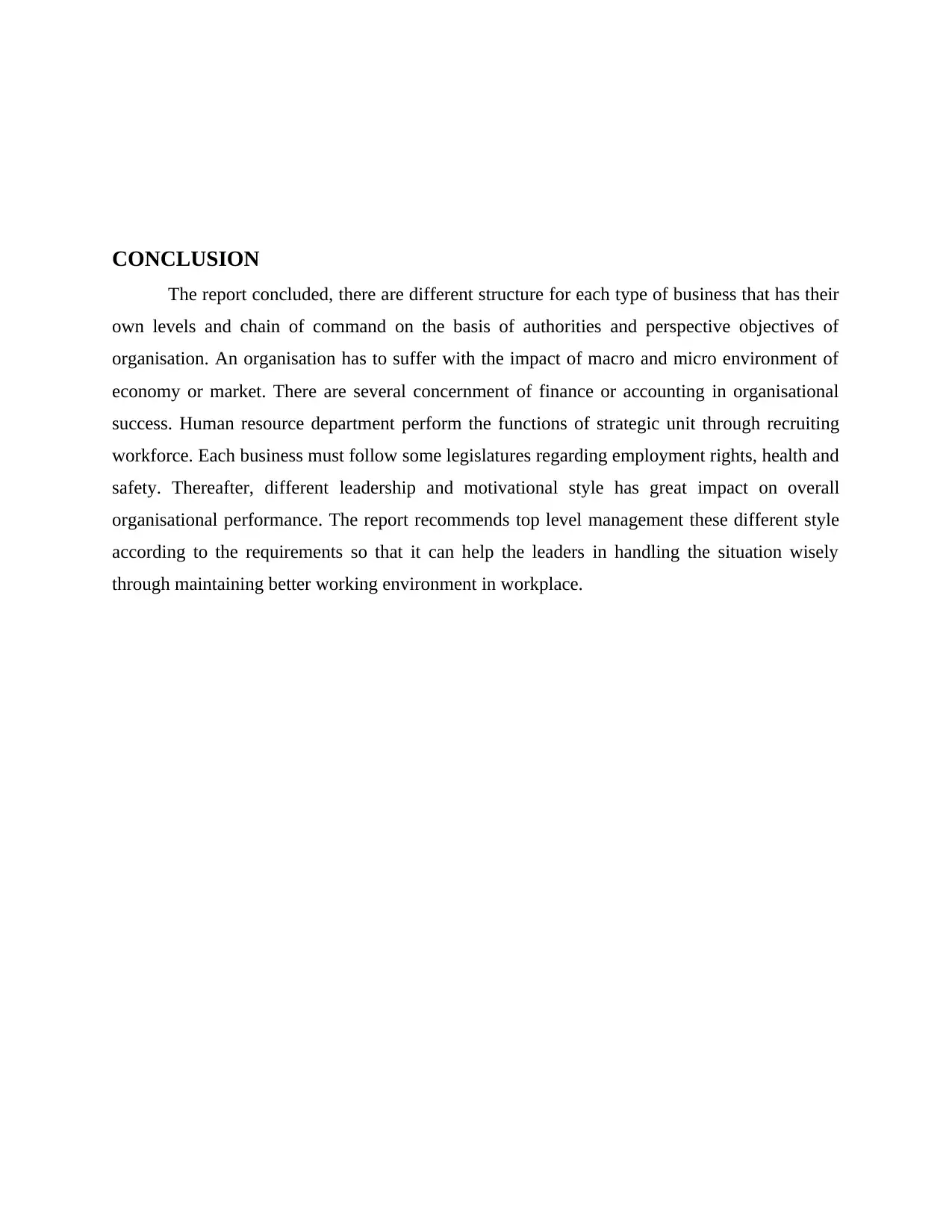
CONCLUSION
The report concluded, there are different structure for each type of business that has their
own levels and chain of command on the basis of authorities and perspective objectives of
organisation. An organisation has to suffer with the impact of macro and micro environment of
economy or market. There are several concernment of finance or accounting in organisational
success. Human resource department perform the functions of strategic unit through recruiting
workforce. Each business must follow some legislatures regarding employment rights, health and
safety. Thereafter, different leadership and motivational style has great impact on overall
organisational performance. The report recommends top level management these different style
according to the requirements so that it can help the leaders in handling the situation wisely
through maintaining better working environment in workplace.
The report concluded, there are different structure for each type of business that has their
own levels and chain of command on the basis of authorities and perspective objectives of
organisation. An organisation has to suffer with the impact of macro and micro environment of
economy or market. There are several concernment of finance or accounting in organisational
success. Human resource department perform the functions of strategic unit through recruiting
workforce. Each business must follow some legislatures regarding employment rights, health and
safety. Thereafter, different leadership and motivational style has great impact on overall
organisational performance. The report recommends top level management these different style
according to the requirements so that it can help the leaders in handling the situation wisely
through maintaining better working environment in workplace.
Paraphrase This Document
Need a fresh take? Get an instant paraphrase of this document with our AI Paraphraser
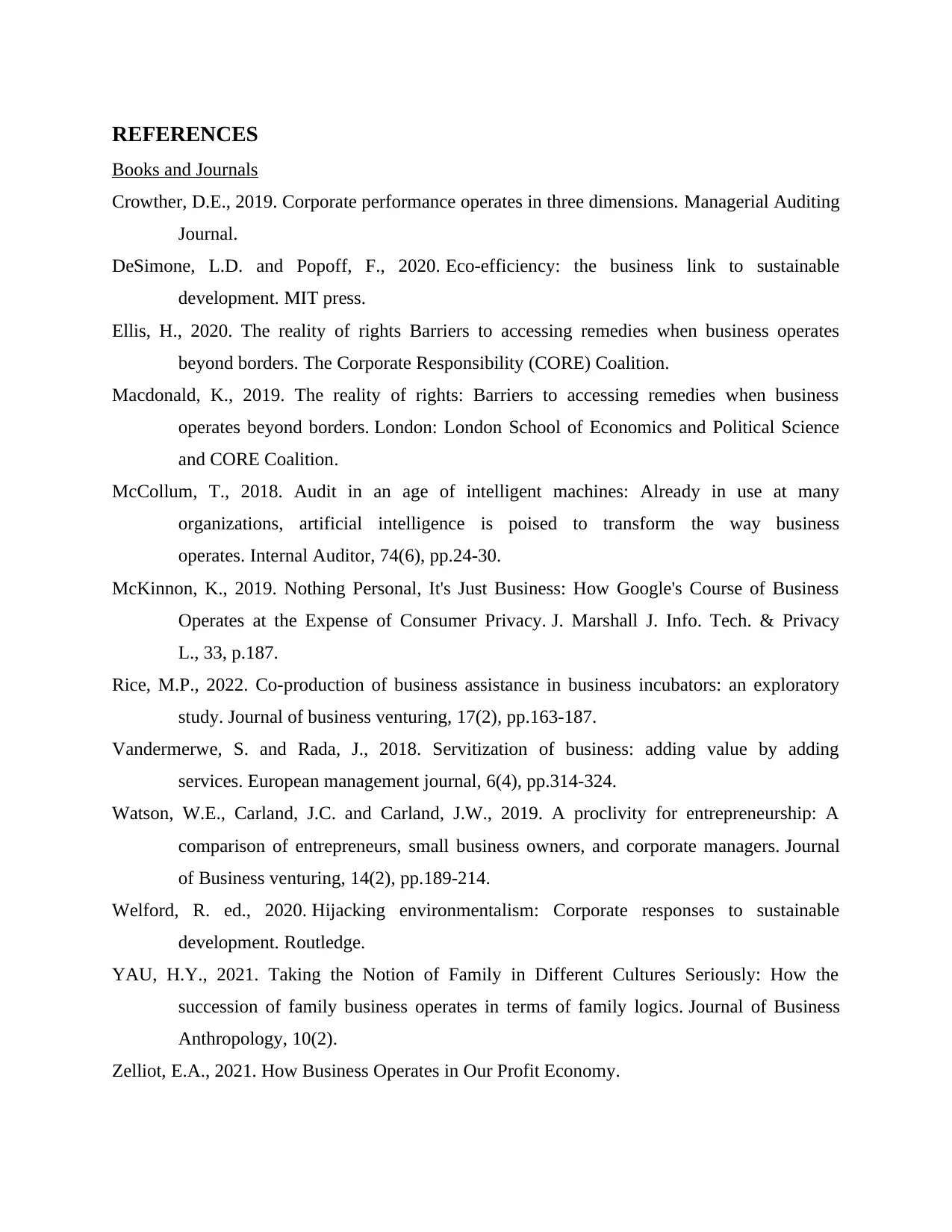
REFERENCES
Books and Journals
Crowther, D.E., 2019. Corporate performance operates in three dimensions. Managerial Auditing
Journal.
DeSimone, L.D. and Popoff, F., 2020. Eco-efficiency: the business link to sustainable
development. MIT press.
Ellis, H., 2020. The reality of rights Barriers to accessing remedies when business operates
beyond borders. The Corporate Responsibility (CORE) Coalition.
Macdonald, K., 2019. The reality of rights: Barriers to accessing remedies when business
operates beyond borders. London: London School of Economics and Political Science
and CORE Coalition.
McCollum, T., 2018. Audit in an age of intelligent machines: Already in use at many
organizations, artificial intelligence is poised to transform the way business
operates. Internal Auditor, 74(6), pp.24-30.
McKinnon, K., 2019. Nothing Personal, It's Just Business: How Google's Course of Business
Operates at the Expense of Consumer Privacy. J. Marshall J. Info. Tech. & Privacy
L., 33, p.187.
Rice, M.P., 2022. Co-production of business assistance in business incubators: an exploratory
study. Journal of business venturing, 17(2), pp.163-187.
Vandermerwe, S. and Rada, J., 2018. Servitization of business: adding value by adding
services. European management journal, 6(4), pp.314-324.
Watson, W.E., Carland, J.C. and Carland, J.W., 2019. A proclivity for entrepreneurship: A
comparison of entrepreneurs, small business owners, and corporate managers. Journal
of Business venturing, 14(2), pp.189-214.
Welford, R. ed., 2020. Hijacking environmentalism: Corporate responses to sustainable
development. Routledge.
YAU, H.Y., 2021. Taking the Notion of Family in Different Cultures Seriously: How the
succession of family business operates in terms of family logics. Journal of Business
Anthropology, 10(2).
Zelliot, E.A., 2021. How Business Operates in Our Profit Economy.
Books and Journals
Crowther, D.E., 2019. Corporate performance operates in three dimensions. Managerial Auditing
Journal.
DeSimone, L.D. and Popoff, F., 2020. Eco-efficiency: the business link to sustainable
development. MIT press.
Ellis, H., 2020. The reality of rights Barriers to accessing remedies when business operates
beyond borders. The Corporate Responsibility (CORE) Coalition.
Macdonald, K., 2019. The reality of rights: Barriers to accessing remedies when business
operates beyond borders. London: London School of Economics and Political Science
and CORE Coalition.
McCollum, T., 2018. Audit in an age of intelligent machines: Already in use at many
organizations, artificial intelligence is poised to transform the way business
operates. Internal Auditor, 74(6), pp.24-30.
McKinnon, K., 2019. Nothing Personal, It's Just Business: How Google's Course of Business
Operates at the Expense of Consumer Privacy. J. Marshall J. Info. Tech. & Privacy
L., 33, p.187.
Rice, M.P., 2022. Co-production of business assistance in business incubators: an exploratory
study. Journal of business venturing, 17(2), pp.163-187.
Vandermerwe, S. and Rada, J., 2018. Servitization of business: adding value by adding
services. European management journal, 6(4), pp.314-324.
Watson, W.E., Carland, J.C. and Carland, J.W., 2019. A proclivity for entrepreneurship: A
comparison of entrepreneurs, small business owners, and corporate managers. Journal
of Business venturing, 14(2), pp.189-214.
Welford, R. ed., 2020. Hijacking environmentalism: Corporate responses to sustainable
development. Routledge.
YAU, H.Y., 2021. Taking the Notion of Family in Different Cultures Seriously: How the
succession of family business operates in terms of family logics. Journal of Business
Anthropology, 10(2).
Zelliot, E.A., 2021. How Business Operates in Our Profit Economy.

⊘ This is a preview!⊘
Do you want full access?
Subscribe today to unlock all pages.

Trusted by 1+ million students worldwide
1 out of 12
Related Documents
Your All-in-One AI-Powered Toolkit for Academic Success.
+13062052269
info@desklib.com
Available 24*7 on WhatsApp / Email
![[object Object]](/_next/static/media/star-bottom.7253800d.svg)
Unlock your academic potential
Copyright © 2020–2025 A2Z Services. All Rights Reserved. Developed and managed by ZUCOL.




